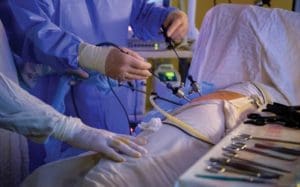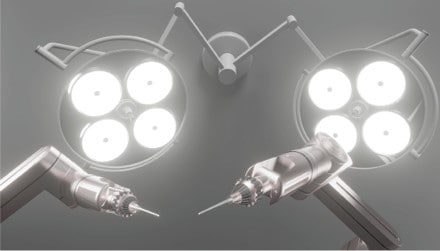
Advancements in minimally invasive surgical (MIS) techniques have been nothing short of miraculous.
Surgical skill sets coupled with new technology and devices have enabled what were once extremely invasive procedures to now simple, minimal incisions for instrument/scope access (trocar or keyhole) ports, and sometimes small diameter catheter vascular access.
However, the need to perform highly skilled actions using specialized tools with limited visibility and motion range has introduced higher levels of expertise for surgical teams, from endoscopic surgeons and robotic procedure specialists to interventional radiologists. Support equipment includes endoscopic cameras, visualization scanners, contrast injectors, non-magnetic monitors, specialized instruments and catheters, and expensive robotic systems. Despite the setup overhead for MIS, there’s no disputing the value these advanced surgical procedures bring to the industry.
MIS device design trends
The devices required to support MIS techniques continue to proliferate at impressive levels. Highly specialized instruments can now perform tasks swiftly without requiring much technique from the user, and the number of individual designs available today to surgeons is quite daunting. It’s common for a power user (key opinion leader or KOL) to develop a device based on their specific technique, which becomes a unique offering from a partnering manufacturer. Miniaturized sensors and electronics can be integrated into the tips of these handheld instruments or within tiny catheters to monitor pressure, blood-flow, and electrical fields, providing clinicians with vital anatomical feedback while working virtually blind. Combined with these sensors, some devices provide synthesized feedback to the user, which may be through haptic vibration and mechanical resistance, or visual and audible instructions.
Robot-assisted surgery has become a fast-moving technology that enhances the accuracy of complex surgeries while reducing patient trauma and recovery time. Robots may be as simplistic as a smart guidance fixture for probes and cannula insertions, or as complex as a floor-standing multi-tool device that operates remotely on patients from across the globe, controlled by skilled surgeons via advanced telemetry. Combined with 3D-imaging and real-time interpolated anatomical modeling, robot-assisted surgical efficacy is driving the proliferation of targeted robotic platforms into most surgical and oncological procedures.
MIS has its challenges – cost of capital equipment such as imaging systems and robots can be prohibitive, and personnel training requires a team of dedicated clinicians and facilities. Cath labs have replaced many operating rooms as interventional procedures have proven their value and effectiveness in treating coronary disease. Today we can have aortic valves replaced via femoral artery-accessed catheter delivery, without requiring thoracic surgical access. Tiny pumps integrated into the ends of catheters can help pump blood from the ventricle to the atrium until hearts can heal from a procedure and operate normally.
Visualization technology
Visualization requirements associated with MIS rely on sophisticated technology to enable the clinician to see through anatomy. Without these advances, most MIS procedures would be impossible to perform with the required levels of accuracy and reliability. Camera complementary metal oxide semiconductor (CMOS) sensors have become so small and affordable that articulating scopes can now visualize anatomy in high-resolution video. Features such as tissue texture and relative coloration can be assessed in real time with HD-enhancing and color-correcting software. The software can interpolate scanned anatomy to provide 3D images, perhaps overlaying pre-scanned patient anatomy to help guide the user around tortuous pathways during device implantation.
Magnetic resonance imaging (MRI), computed tomography (CT), X-ray, ultrasound, fluoroscopy, etc. are all mature technologies, but recent advances in digital image enhancement coupled with computer processing power significantly enhance resolution for MIS applications. MRI imaging has a unique problem: equipment in the MRI suite must be non-ferrous to resist the massive magnetic fields created by the scanner. Patients that require 24/7 hook-up to critical-care monitors and life support devices such as ventilators, pumps, and monitors rely on these special MRI-compatible devices.

CT imaging requires the introduction of contrast solution into the patient’s vasculature to provide an appropriate image, with the ability to customize the consistency of the contrast solution to match each patient’s anatomy and optimize image clarity. Modern injectors provide numerous settings, including preset and custom ratios of contrast-to-saline fluid mix, pressure, and ramp profiles.
Perhaps ultrasound (U/S) imaging has offered the greatest opportunity to caregivers most recently as it’s a compact (briefcase-sized), simple, safe, inexpensive technology. U/S is increasingly being paired with a broad base of diagnostic and simple therapeutic procedures in outpatient and doctors’ office settings. An example is the imaging of air-infused saline for fallopian tube patency where the saline-based contrast medium and imaging system are less expensive and safer than other traditional imaging methods. It’s easy to extrapolate the transition of U/S imaging into home-health telemedicine (distance-care) in the future, including patient-operated fetal monitoring.
User-centered design
Beyond the availability of cutting-edge instruments and devices, MIS specialists must develop specific skill sets. While open-heart surgery requires immense skill, imagine performing a transcatheter aortic valve replacement entirely from a groin-area access site. External grips at the end of long cannulae or worse, hub-located control interfaces at the proximal end of a 2m long, spaghetti-like catheter must be able to push, pull, turn, and activate features deep inside the body. With either laparoscopic or interventional techniques, consider the lack of direct interface and low-to-zero tactile feedback coupled with compromised visualization.
It’s important that MIS devices minimize errors from poor ergonomics, repetitive stress, and non-intuitive control design. When the clinician’s eyes are on the camera monitor, they shouldn’t have to refocus on the device in hand because the clinician can’t find the adjustment feature. To assist with these challenges, some devices can be coupled to controllers that provide feedback such as temperature, pressure and flow sensing, and high-precision deployment of miniature tools integrated within the distal tip of the embedded device. These controllers can help operators feel their way around the anatomy, providing continuous monitoring of critical parameters.
Device manufacturers are always searching for ways to de-skill the MIS process so the average operator can succeed without rigorous training. Some designers have tried synthesizing feedback into devices, such as adding electromechanically generated haptic (vibration, pulsing, resistance), and audible and visual feedback to denote various functional states. Unfortunately, most of these devices are also single use, so unit costs must also be contained, adding to the challenges to optimize ergonomics. One strategy is to build the feedback features into a durable (reusable) part of the device so the cost can be amortized over many cases. Miniaturization technology has also advanced to the point where the cost of medical-grade embedded sensors is becoming affordable and highly accurate.
MIS technology’s future
Despite MIS advancements, techniques are still in their adolescence. As component performance increases and cost decreases, we can expect to see convergence of many technologies that’ll enable device manufacturers to deliver smaller, more accurate and less expensive devices that are easier to operate for a range of procedures. Similar to how trans-catheter aortic valve replacement has been a disruptive innovation, miniaturized robotics, nano-actuators, electronics, and higher-definition optics can provide greater remote functionality at the end of a laparoscopic cannula or vascular catheter. Perhaps tiny, pre-programmed robots may one day be injected into the bloodstream or pulmonary airway where they autonomously do surgeons’ jobs with little or no trauma to the patient. Biologically engineered viruses (like recent mRNA COVID-19 vaccines) may also be able to function at the cellular level to obliterate cancer and other abnormalities.
Although these scenarios may sound like they’ve been pilfered from scientific journals, one fact is clear; medical technology in the minimally invasive space is accelerating faster than ever, which can only benefit the entire healthcare continuum in the long run.
Originally posted on Today’s Medical Developments. December 2021.



